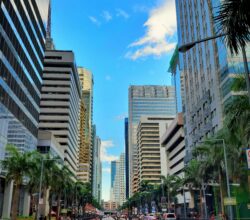Quezon City, the largest and one of the most populous cities in Metro Manila, has long been recognized as a hub for commerce and culture. With a total land area of 161.11 square kilometers, the city embraces new public infrastructure projects as it gears up to be the most connected metropolis in the country.
This enhanced connectivity is drawing significant interest from real estate investors and high-level professionals seeking growth opportunities. With transport upgrades linking Quezon City more closely to the rest of Metro Manila, it’s time to consider the city’s unique real estate potential.
Key Transport Infrastructure in Quezon City
As QC gears up to become the “most connected city”, several transformative projects are underway.
Metro Manila Skyway Stage 3 (MMSS-3)
The MMSS-3 is an elevated expressway that links the North Luzon Expressway (NLEX) with the South Luzon Expressway (SLEX). This significantly reduces the travel time across the metro. Once completed, residents will be able to travel from Quezon City to Makati in less than 15 minutes, making it easier for professionals to work in various business districts while living in a well-connected development. This project not only benefits commuters, but also opens up Quezon City

Alveo Land’s Sentrove at Cloverleaf: A 43-storey residence in Balintawak, QC offering accessible city living with direct links to EDSA, A. Bonifacio, and Skyway Stage 3.
Metro Manila Subway (MMS)
The MMS project is the first mass underground transit system in the Philippines, spanning 30 kilometers with 15 stations. Three of these stations will be in Quezon City, particularly on Mindanao Avenue, Tandang Sora, and North Avenue. The site is expected to be partially opened soon and will connect Quezon City to other areas in Metro Manila, including the Ninoy Aquino International Airport, in just 30 minutes. This accessibility makes Quezon City highly attractive for real estate investors and businesses looking to establish a presence near this major transport artery.
Metro Rail Transit Line 7 (MRT-7)
MRT-7 line connects San Jose del Monte in Bulacan to North Avenue in Quezon City. It will feature 14 stations and should ease traffic congestion while making commuting across the region more efficient. The project is nearing completion and will drive up property values – offering long-term growth for investors and improve livability of residents.

At the heart of Vertis North, Alveo Land’s Orean Residences offers direct access to EDSA, North Avenue, Agham Road, MRT, LRT, the Metro Manila Subway, and Grand Central Station, connecting residents to the city with ease.
Current Transport
For residents and commuters, public transportation options like jeepneys, city buses, and the UV Express remain popular. The local government even distributed hundreds of e-trikes across various barangays, promoting cleaner and energy-efficient alternatives. By 2021, the city has also started operating the QCity Bus Service which provides city-wide routes to improve transit access, while reducing dependency on private vehicles.
How Connectivity Improves Real Estate Investment Potential
Investing in real estate within well-connected areas has proven to yield solid returns. For Quezon City, this means an optimistic outlook for growth in property values as the city’s transport network expands. Properties within a kilometer of these new stations are particularly valuable with increased demand anticipated for both residential and commercial spaces.
As infrastructure projects progress, now is the time to consider the potential of investing in a city where connectivity blends with opportunity. With each new link, QC cements its status as a premier investment destination – one where convenience takes top status.
Share







